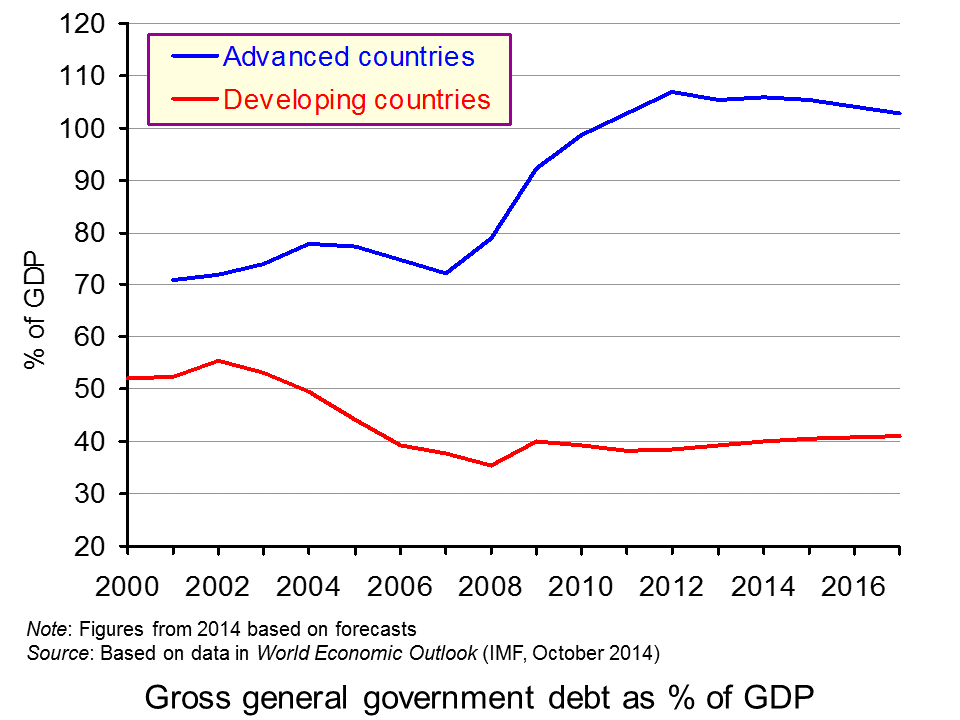 Some commentators have seen the victory of Donald Trump and, prior to that, the Brexit vote as symptoms of a crisis in capitalism. Much of the campaigning in the US election, both by Donald Trump on the right and Bernie Sanders on the left focused on the plight of the poor. Whether the blame was put on immigration, big government, international organisations, the banks, cheap imports undercutting jobs or a lack of social protection, the message was clear: capitalism is failing to improve the lot of the majority. A small elite is getting significantly richer while the majority sees little or no gain in their living standards and a rise in uncertainty.
Some commentators have seen the victory of Donald Trump and, prior to that, the Brexit vote as symptoms of a crisis in capitalism. Much of the campaigning in the US election, both by Donald Trump on the right and Bernie Sanders on the left focused on the plight of the poor. Whether the blame was put on immigration, big government, international organisations, the banks, cheap imports undercutting jobs or a lack of social protection, the message was clear: capitalism is failing to improve the lot of the majority. A small elite is getting significantly richer while the majority sees little or no gain in their living standards and a rise in uncertainty.
The articles below look at this crisis. They examine the causes, which they agree go back many years as capitalism has evolved. The financial crash of 2008 and the slow recovery since are symptomatic of the underlying changes in capitalism.
The Friedman article focuses on the slowing growth in technological advance and the problem of aging populations. What technological progress there is is not raising incomes generally, but is benefiting a few entrepreneurs and financiers. General rises in income may eventually come, but it may take decades before robotics, biotechnological advances, e-commerce and other breakthrough technologies filter through to higher incomes for everyone. In the meantime, increased competition through globalisation is depressing the incomes of the poor and economically immobile.
 All the articles look at the rise of the rich. The difference with the past is that the people who are gaining the most are not doing so from production but from financial dealing or rental income; they have gained while the real economy has stagnated.
All the articles look at the rise of the rich. The difference with the past is that the people who are gaining the most are not doing so from production but from financial dealing or rental income; they have gained while the real economy has stagnated.
The gains to the rich have come from the rise in the value of assets, such as equities (shares) and property, and from the growth in rental incomes. Only a small fraction of finance is used to fund business investment; the majority is used for lending against existing assets, which then inflates their prices and makes their owners richer. In other words, the capitalist system is moving from driving growth in production to driving the inflation of asset prices and rental incomes.
The process whereby financial markets grow and in turn drive up asset prices is known as ‘financialisation’. Not only is the process moving away from funding productive investment and towards speculative activity, it is leading to a growth in ‘short-termism’. The rewards of senior managers often depend on the price of their companies’ shares. This leads to a focus on short-term profit and a neglect of long-term growth and profitability – to a neglect of investment in R&D and physical capital.
The process of financialisation has been driven by deregulation, financial innovation, the growth in international financial flows and, more recently, by quantitative easing and low interest rates. It has led to a growth in private debt which, in turn, creates more financial instability. The finance industry has become so profitable that even manufacturing companies are moving into the business of finance themselves – often finding it more profitable than their core business. As the Foroohar article states, “the biggest unexplored reason for long-term slower growth is that the financial system has stopped serving the real economy and now serves mainly itself.”
 So will the election of Donald Trump, and pressure from populism in other countries too, mean that governments will focus more on production, job creation and poverty reduction? Will there be a movement towards fiscal policy to drive infrastructure spending? Will there be a reining in of loose monetary policy and easy credit?
So will the election of Donald Trump, and pressure from populism in other countries too, mean that governments will focus more on production, job creation and poverty reduction? Will there be a movement towards fiscal policy to drive infrastructure spending? Will there be a reining in of loose monetary policy and easy credit?
Or will addressing the problem of financialisation and the crisis of capitalism result in the rich continuing to get richer at the expense of the poor, but this time through more conventional channels, such as increased production and monopoly profits and tax cuts for the rich? Trump supporters from among the poor hope the answer is no. Those who supported Bernie Sanders in the Democratic primaries think the answer will be yes and that the solution to over financialisation requires more, not less, regulation, a rise in minimum wages and fiscal policies aimed specifically at the poor.
Articles
Can Global Capitalism Be Saved? Project Syndicate, Alexander Friedman (11/11/16)
American Capitalism’s Great Crisis Time, Rana Foroohar (12/5/16)
The Corruption of Capitalism by Guy Standing review – work matters less than what you own The Guardian, Katrina Forrester (26/10/16)
Questions
- Do you agree that capitalism is in crisis? Explain.
- What is meant by financialisation? Why has it grown?
- Will the policies espoused by Donald Trump help to address the problems caused by financialisation?
- What alternative policies are there to those of Trump for addressing the crisis of capitalism?
- Explain Schumpeter’s analysis of creative destruction.
- What technological innovations that are currently taking place could eventually benefit the poor as well as the rich?
- What disincentives are there for companies investing in R&D and new equipment?
- What are the arguments for and against a substantial rise in the minimum wage?
 ‘The world is sinking under a sea of debt, private as well as public, and it is increasingly hard to see how this might end, except in some form of mass default.’ So claims the article below by Jeremy Warner. But just how much has debt grown, both public and private? And is it of concern?
‘The world is sinking under a sea of debt, private as well as public, and it is increasingly hard to see how this might end, except in some form of mass default.’ So claims the article below by Jeremy Warner. But just how much has debt grown, both public and private? And is it of concern?
The doomsday scenario is that we are heading for another financial crisis as over leveraged banks and governments could not cope with a collapse in confidence. Bank and bond interest rates would soar and debts would be hard to finance. The world could head back into recession as credit became harder and more expensive to obtain. Perhaps, in such a scenario, there would be mass default, by banks and governments alike. This could result in a plunge back into recession.
The more optimistic scenario is that private-sector debt is under control and in many countries is falling (see, for example, chart 1 in the blog Looking once again through Minsky eyes at UK credit numbers for the case of the UK). Even though private-sector debt could rise again as the world economy grows, it would be affordable provided that interest rates remain low and banks continue to build the requisite capital buffers under the Basel III banking regulations.
 As far as public-sector debt is concerned, as a percentage of GDP its growth has begun to decline in advanced countries as a whole and, although gently rising in developing and emerging economies as a whole, is relatively low compared with advanced countries (see chart). Of course, there are some countries that still face much larger debts, but in most cases they are manageable and governments have plans to curb them, or at least their growth.
As far as public-sector debt is concerned, as a percentage of GDP its growth has begun to decline in advanced countries as a whole and, although gently rising in developing and emerging economies as a whole, is relatively low compared with advanced countries (see chart). Of course, there are some countries that still face much larger debts, but in most cases they are manageable and governments have plans to curb them, or at least their growth.
But there have been several warnings from various economists and institutes, as we saw in the blog post, Has the problem of excess global debt been tackled? Not according to latest figures. The question is whether countries can grow their way out of the problem, with a rapidly rising denominator in the debt/GDP ratios.
Only mass default will end the world’s addiction to debt The Telegraph, Jeremy Warner (3/3/15)
Questions
- What would be the impact of several countries defaulting on debt?
- What factors determine the likelihood of sovereign defaults?
- What factors determine the likelihood of bank defaults?
- What is meant by ‘leverage’ in the context of (a) banks; (b) nations?
- What are the Basel III regulations? What impact will they have/are they having on bank leverage?
- Expand on the arguments supporting the doomsday scenario above.
- Expand on the arguments supporting the optimistic scenario above.
- What is the relationship between economic growth and debt?
- Explain how the explosion in global credit might merely be ‘the mirror image of rising output, asset prices and wealth’.
- Is domestic inflation a good answer for a country to the problems of rising debt denominated (a) in the domestic currency; (b) in foreign currencies?
 According to a report by the McKinsey Global Institute, global debt is now higher than before the financial crisis. And that crisis was largely caused by excessive lending. As The Telegraph article linked below states:
According to a report by the McKinsey Global Institute, global debt is now higher than before the financial crisis. And that crisis was largely caused by excessive lending. As The Telegraph article linked below states:
The figures are as remarkable as they are terrifying. Global debt – defined as the liabilities of governments, firms and households – has jumped by $57 trillion, or 17% of global GDP, since the fourth quarter of 2007, which was supposed to be the peak of the bad old credit-fuelled days. In 2000, total debt was worth 246% of global GDP; by 2007, this had risen to 269% of GDP and today we are at 286% of GDP.
This is not how policy since the financial crisis was supposed to have worked out. Central banks and governments have been trying to encourage greater saving and reduced credit as a percentage of  GDP, a greater capital base for banks, and reduced government deficits as a means of reducing government debt. But of 47 large economies in the McKinsey study, only five have succeeded in reducing their debt/GDP ratios since 2007 and in many the ratio has got a lot higher. China, for example, has seen its debt to GDP ratio almost double – from 158% to 282%, although its government debt remains low relative to other major economies.
GDP, a greater capital base for banks, and reduced government deficits as a means of reducing government debt. But of 47 large economies in the McKinsey study, only five have succeeded in reducing their debt/GDP ratios since 2007 and in many the ratio has got a lot higher. China, for example, has seen its debt to GDP ratio almost double – from 158% to 282%, although its government debt remains low relative to other major economies.
Part of the problem is that the lack of growth in many countries has made it hard for countries to reduce their public-sector deficits to levels that will allow the public-sector debt/GDP ratio to fall.
In terms of the UK, private-sector debt has been falling as a percentage of GDP. But this has been more than offset by a rise in the public-sector debt/GDP ratio. As Robert Peston says:
[UK indebtedness] increased by 30 percentage points, to 252% of GDP (excluding financial sector or City debts) – as government debts have jumped by 50 percentage points of GDP, while corporate and household debts have decreased by 12 and 8 percentage points of GDP respectively.
So what are the likely consequences of this growth in debt and what can be done about it? The articles and report consider these questions.
Articles
Instead of paying down its debts, the world’s gone on another credit binge The Telegraph, Allister Heath (5/2/15)
Global debts rise $57tn since crash BBC News, Robert Peston (5/2/15)
China’s Total Debt Load Equals 282% of GDP, Raising Economic Risks The Wall Street Journal, Pedro Nicolaci da Costa (4/2/15)
Report
Debt and (not much) deleveraging McKinsey Global Institute, Richard Dobbs, Susan Lund, Jonathan Woetzel, and Mina Mutafchieva (February 2015)
Questions
- Explain what is meant by ‘leverage’.
- Why does a low-leverage economy do better in a downturn than a high-leverage one?
- What is the relationship between deficits and the debt/GDP ratio?
- When might an increase in debt be good for an economy?
- Comment on the statement in The Telegraph article that ‘In theory, debt is fine if it is backed up by high-quality collateral’.
- Why does the rise is debt matter for the global economy?
- Is it possible for (a) individual countries; (b) all countries collectively to ‘live beyond their means’ by consuming more than they are producing through borrowing?
- What is the structure of China’s debt and what problems does this pose for the Chinese economy?
 The first link below is to an excellent article by Noriel Roubini, Professor of Economics at New York University’s Stern School of Business. Roubini was one of the few economists to predict the 2008 financial crisis and subsequent recession. In this article he looks at the current problem of substantial deficiency of demand: in other words, where actual output is well below potential output (a negative output gap). It is no wonder, he argues, that in these circumstances central banks around the world are using unconventional monetary policies, such as virtually zero interest rates and quantitative easing (QE).
The first link below is to an excellent article by Noriel Roubini, Professor of Economics at New York University’s Stern School of Business. Roubini was one of the few economists to predict the 2008 financial crisis and subsequent recession. In this article he looks at the current problem of substantial deficiency of demand: in other words, where actual output is well below potential output (a negative output gap). It is no wonder, he argues, that in these circumstances central banks around the world are using unconventional monetary policies, such as virtually zero interest rates and quantitative easing (QE).
He analyses the causes of deficiency of demand, citing banks having to repair their balance sheets, governments seeking to reduce their deficits, attempts by firms to cut costs, effects of previous investment in commodity production and rising inequality.
 The second link is to an article about the prediction by the eminent fund manager, Crispin Odey, that central banks are running out of options and that the problem of over-supply will lead to a global slump and a stock market crash that will be ‘remembered in a hundred years’. Odey, like Roubini, successfully predicted the 2008 financial crisis. Today he argues that the looming ‘down cycle will cause a great deal of damage, precisely because it will happen despite the efforts of central banks to thwart it.’
The second link is to an article about the prediction by the eminent fund manager, Crispin Odey, that central banks are running out of options and that the problem of over-supply will lead to a global slump and a stock market crash that will be ‘remembered in a hundred years’. Odey, like Roubini, successfully predicted the 2008 financial crisis. Today he argues that the looming ‘down cycle will cause a great deal of damage, precisely because it will happen despite the efforts of central banks to thwart it.’
I’m sorry to post this pessimistic blog and you can find other forecasters who argue that QE by the ECB will be just what is needed to stimulate economic growth in the eurozone and allow it to follow the USA and the UK into recovery. That’s the trouble with economic forecasting. Forecasts can vary enormously depending on assumptions about variables, such as future policy measures, consumer and business confidence, and political events that themselves are extremely hard to predict.
Will central banks continue to deploy QE if the global economy does falter? Will governments heed the advice of the IMF and others to ease up on deficit reduction and engage in a substantial programme of infrastructure investment? Who knows?
An Unconventional Truth Project Syndicate, Nouriel Roubini (1/2/15)
UK fund manager predicts stock market plunge during next recession The Guardian, Julia Kollewe (30/1/15)
Questions
- Explain each of the types of unconventional monetary policy identified by Roubini.
- How has a policy of deleveraging by banks affected the impact of quantitative easing on aggregate demand?
- Assume you predict that global economic growth will increase over the next two years. What reasons might you give for your prediction?
- Why have most commodity prices fallen in recent months? (In the second half of 2014, the IMF all-commodity price index fell by 28%.)
- What is likely to be the impact of falling commodity prices on global demand?
- Some neo-liberal economists had predicted that central bank policies ‘would lead to hyperinflation, the US dollar’s collapse, sky-high gold prices, and the eventual demise of fiat currencies at the hands of digital krypto-currency counterparts’. Why, according to Roubini, did the ‘root of their error lie in their confusion of cause and effect’?
The UK and US governments face a conundrum. To achieve economic recovery, aggregate demand needs to expand. This means that one or more of consumption, government expenditure, exports and investment must rise. But the government is trying to reduce government expenditure in order to reduce the size of the public-sector deficit and debt; exports are being held back by the slow recovery, or even return to recession, in the eurozone and the USA; and investment is being dampened by business pessimism. This leaves consumer expenditure. For recovery, High Street spending needs to rise.
But herein lies the dilemma. For consumer spending to rise, people need to save less and/or borrow more. But UK and US saving rates are already much lower than in many other countries. You can see this by examining Table 23 in OECD Economic Outlook. Also, household debt is much higher in the UK and USA. This has been largely the result of the ready availability of credit through credit cards and other means. The government is keen to encourage people to save more and to reduce their reliance on debt – in other words, to start paying off their credit-card and other debt. That way, the government hopes, the economy will become ‘rebalanced’. But this rebalancing, in the short run at least, will dampen aggregate demand. And that will hardly help recovery!
In the following podcast, Sheldon Garon discusses his new book Beyond Our Means. He describes the decline of saving in the USA and UK and examines why other countries have had much higher saving rates.
‘He also seeks to explain why high interest rates didn’t encourage saving in the boom years and why current levels of relatively high inflation haven’t stopped savings rates shooting up again in Britain.’
 Living beyond our means Guardian: the Business Podcast, Sheldon Garon talks to Tom Clark (2/11/11)
Living beyond our means Guardian: the Business Podcast, Sheldon Garon talks to Tom Clark (2/11/11)
Questions
- Why have saving rates in the UK and USA been much lower than those in many other countries? How significant has been the availability of credit in determining savings rates?
- Why have saving rates increased in the UK and USA since 2008/9 despite negative real interest rates in many months?
- Explain what is meant by the “paradox of thrift”. What are the implications of this paradox for government policy at the present time?
- Why may it be difficult to have a consumer-led recovery in the UK and US economies?
- What is the life-cycle theory of consumption and saving? How well does it explain saving rates?
- Can people be given a “nudge” to spend more or to save more? If so, what nudges might be appropriate in the current situation?
- Why do countries with a more equal distribution of income have higher saving rates?
- What is the relationship between the saving rate and (a) the rate of inflation and (b) the real rate of interest? Why is this the case?
 Some commentators have seen the victory of Donald Trump and, prior to that, the Brexit vote as symptoms of a crisis in capitalism. Much of the campaigning in the US election, both by Donald Trump on the right and Bernie Sanders on the left focused on the plight of the poor. Whether the blame was put on immigration, big government, international organisations, the banks, cheap imports undercutting jobs or a lack of social protection, the message was clear: capitalism is failing to improve the lot of the majority. A small elite is getting significantly richer while the majority sees little or no gain in their living standards and a rise in uncertainty.
Some commentators have seen the victory of Donald Trump and, prior to that, the Brexit vote as symptoms of a crisis in capitalism. Much of the campaigning in the US election, both by Donald Trump on the right and Bernie Sanders on the left focused on the plight of the poor. Whether the blame was put on immigration, big government, international organisations, the banks, cheap imports undercutting jobs or a lack of social protection, the message was clear: capitalism is failing to improve the lot of the majority. A small elite is getting significantly richer while the majority sees little or no gain in their living standards and a rise in uncertainty. All the articles look at the rise of the rich. The difference with the past is that the people who are gaining the most are not doing so from production but from financial dealing or rental income; they have gained while the real economy has stagnated.
All the articles look at the rise of the rich. The difference with the past is that the people who are gaining the most are not doing so from production but from financial dealing or rental income; they have gained while the real economy has stagnated. So will the election of Donald Trump, and pressure from populism in other countries too, mean that governments will focus more on production, job creation and poverty reduction? Will there be a movement towards fiscal policy to drive infrastructure spending? Will there be a reining in of loose monetary policy and easy credit?
So will the election of Donald Trump, and pressure from populism in other countries too, mean that governments will focus more on production, job creation and poverty reduction? Will there be a movement towards fiscal policy to drive infrastructure spending? Will there be a reining in of loose monetary policy and easy credit?




